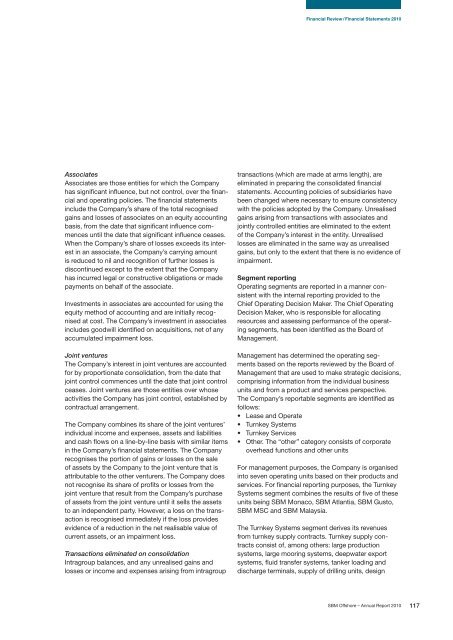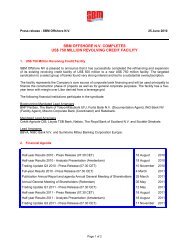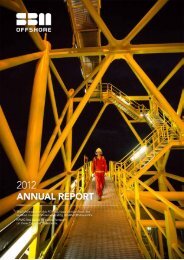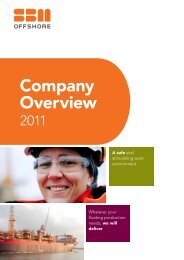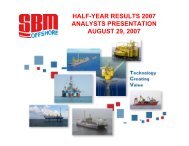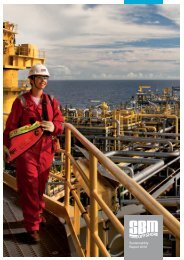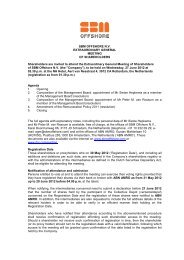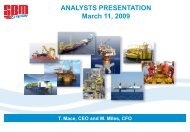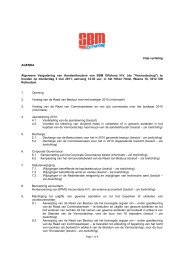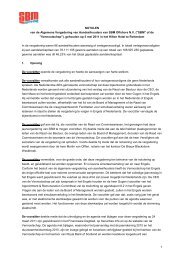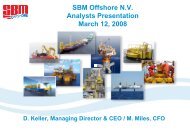Annual Report 2010 - SBM Offshore
Annual Report 2010 - SBM Offshore
Annual Report 2010 - SBM Offshore
Create successful ePaper yourself
Turn your PDF publications into a flip-book with our unique Google optimized e-Paper software.
Associates<br />
Associates are those entities for which the Company<br />
has significant influence, but not control, over the financial<br />
and operating policies. The financial statements<br />
include the Company’s share of the total recognised<br />
gains and losses of associates on an equity accounting<br />
basis, from the date that significant influence commences<br />
until the date that significant influence ceases.<br />
When the Company’s share of losses exceeds its interest<br />
in an associate, the Company’s carrying amount<br />
is reduced to nil and recognition of further losses is<br />
discontinued except to the extent that the Company<br />
has incurred legal or constructive obligations or made<br />
payments on behalf of the associate.<br />
Investments in associates are accounted for using the<br />
equity method of accounting and are initially recognised<br />
at cost. The Company’s investment in associates<br />
includes goodwill identified on acquisitions, net of any<br />
accumulated impairment loss.<br />
Joint ventures<br />
The Company’s interest in joint ventures are accounted<br />
for by proportionate consolidation, from the date that<br />
joint control commences until the date that joint control<br />
ceases. Joint ventures are those entities over whose<br />
activities the Company has joint control, established by<br />
contractual arrangement.<br />
The Company combines its share of the joint ventures’<br />
individual income and expenses, assets and liabilities<br />
and cash flows on a line-by-line basis with similar items<br />
in the Company’s financial statements. The Company<br />
recognises the portion of gains or losses on the sale<br />
of assets by the Company to the joint venture that is<br />
attributable to the other venturers. The Company does<br />
not recognise its share of profits or losses from the<br />
joint venture that result from the Company’s purchase<br />
of assets from the joint venture until it sells the assets<br />
to an independent party. However, a loss on the transaction<br />
is recognised immediately if the loss provides<br />
evidence of a reduction in the net realisable value of<br />
current assets, or an impairment loss.<br />
Transactions eliminated on consolidation<br />
Intragroup balances, and any unrealised gains and<br />
losses or income and expenses arising from intragroup<br />
Financial Review / Financial Statements <strong>2010</strong><br />
transactions (which are made at arms length), are<br />
eliminated in preparing the consolidated financial<br />
statements. Accounting policies of subsidiaries have<br />
been changed where necessary to ensure consistency<br />
with the policies adopted by the Company. Unrealised<br />
gains arising from transactions with associates and<br />
jointly controlled entities are eliminated to the extent<br />
of the Company’s interest in the entity. Unrealised<br />
losses are eliminated in the same way as unrealised<br />
gains, but only to the extent that there is no evidence of<br />
impairment.<br />
Segment reporting<br />
Operating segments are reported in a manner consistent<br />
with the internal reporting provided to the<br />
Chief Operating Decision Maker. The Chief Operating<br />
Decision Maker, who is responsible for allocating<br />
resources and assessing performance of the operating<br />
segments, has been identified as the Board of<br />
Management.<br />
Management has determined the operating segments<br />
based on the reports reviewed by the Board of<br />
Management that are used to make strategic decisions,<br />
comprising information from the individual business<br />
units and from a product and services perspective.<br />
The Company’s reportable segments are identified as<br />
follows:<br />
• Lease and Operate<br />
• Turnkey Systems<br />
• Turnkey Services<br />
• Other. The “other” category consists of corporate<br />
overhead functions and other units<br />
For management purposes, the Company is organised<br />
into seven operating units based on their products and<br />
services. For financial reporting purposes, the Turnkey<br />
Systems segment combines the results of five of these<br />
units being <strong>SBM</strong> Monaco, <strong>SBM</strong> Atlantia, <strong>SBM</strong> Gusto,<br />
<strong>SBM</strong> MSC and <strong>SBM</strong> Malaysia.<br />
The Turnkey Systems segment derives its revenues<br />
from turnkey supply contracts. Turnkey supply contracts<br />
consist of, among others: large production<br />
systems, large mooring systems, deepwater export<br />
systems, fluid transfer systems, tanker loading and<br />
discharge terminals, supply of drilling units, design<br />
<strong>SBM</strong> <strong>Offshore</strong> – <strong>Annual</strong> <strong>Report</strong> <strong>2010</strong> 117


